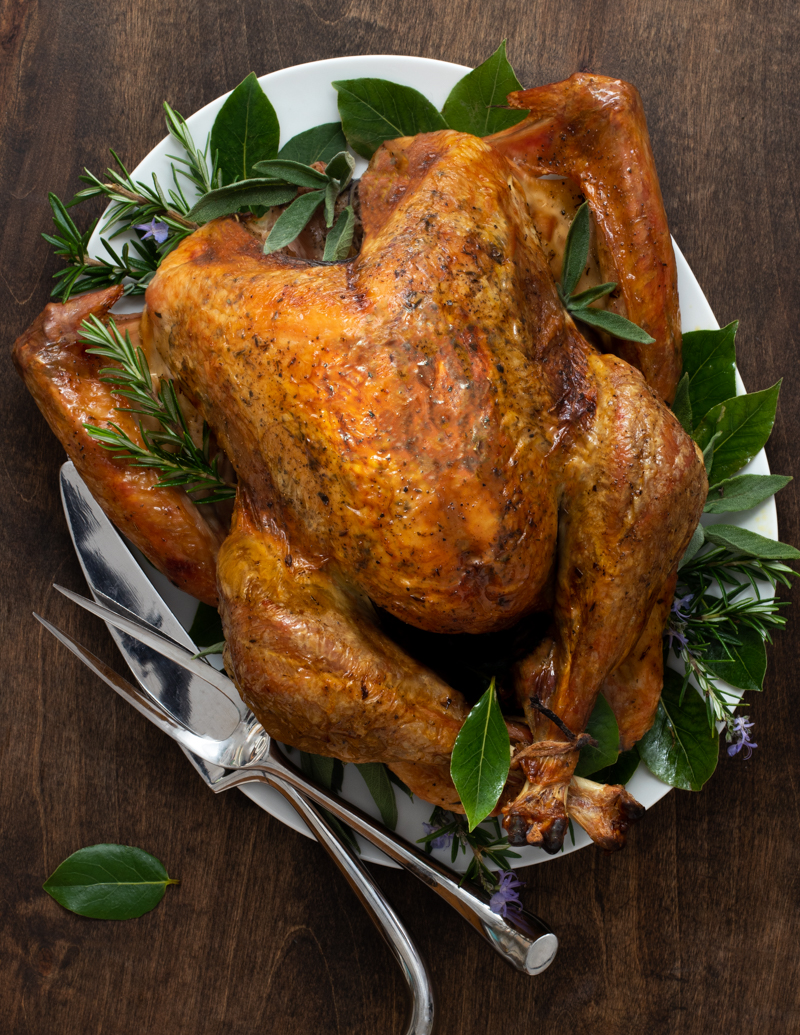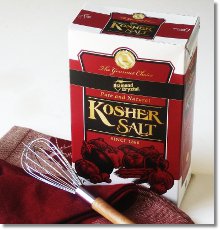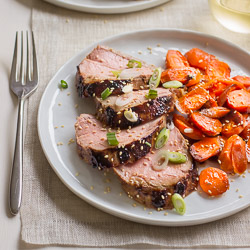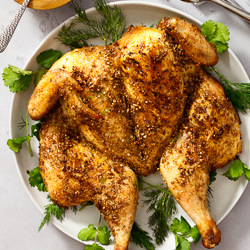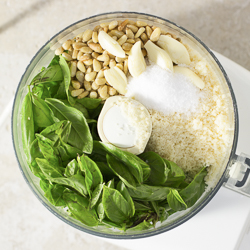You’ve heard of brining of course, and you’ve probably brined more than one turkey by now.
But I want to tell you about my new favorite thing—dry brining! it’s the best!—and why it’s the way to go with your Thanksgiving turkey, like my Simple Herby Dry-Brined Turkey recipe pictured here. But don’t stop there. Dry brining is also amazing for steaks, chops, chicken, and more.
Seriously. Since I’ve started dry brining I haven’t stopped. It makes everything better—and it’s crazy-easy.
A brining review
Brining, as you surely know and as I explained in this post a few years ago, is simply soaking food in a saltwater solution. Through the magic of osmosis and diffusion, the solution gets into the meat, seasoning it and making it juicier.
So what’s dry brining?
Dry brining is a relatively new term, but professional cooks have been doing it for years—that is, salting food long in advance of cooking. It’s also called pre-salting and Judy Rodgers is probably most well-known for doing it to make her Zuni Café roast chickens famously delicious.
Like a regular or wet brine, a dry brine might include flavorings in addition to salt—ingredients like herbs, seasonings, and/or sugar (all of which I include in my Simple Herby Dry-Brined Turkey). But while a wet brine is a watery solution, a dry brine has no liquid.
A dry brine works just like a wet brine, with salt drawing out a food’s liquids via osmosis. In a dry brine, the liquid mixes with the salt on the surface of the food, dissolving it and essentially creating a highly concentrated wet brine. Then through diffusion, that brine is reabsorbed into the food.
Why bother?
As with wet brining, the benefit is more flavorful and juicier food. The biggest benefit of dry brining, however, is that it’s eons easier. Especially with a turkey. No need to find a huge pot or plastic garbage bag to house your bird and the gallons of salty water it’s swimming in. Simply arrange your salted turkey on a rack, arrange the rack on a rimmed baking sheet, and refrigerate.
Another benefit of dry brining over wet is browner, crispier food. Because once the salt draws out the moisture in the food, the resulting concentrated brine is absorbed back in and the meat’s surface is dry. That means turkey and other poultry will get browner, crispier skin, but it also means that steaks, chops, chicken pieces, and fish fillets will get a nicer seared crust.
When and how to dry brine
For steaks, chops, chicken pieces, or fish fillets, use only as much salt as you’d sprinkle on normally before cooking. So it’s not that you’re really seasoning any differently, it’s that you’re seasoning sooner—about 45 minutes sooner. Ideally, after salting put the food on a rack and the rack over a plate. And you don’t need to refrigerate during those 45 minutes because your food should be sitting at room temperature about that long before you cook it anyway.
You’ll know the brining is “done” when your meat is dry on the surface—a sign that the moisture was drawn out and then drawn back in.
For something bigger like a turkey, pork loin, or beef rib roast, you need a pretty heavy hand with the salt. How heavy? Imagine cutting that pork loin into chops and how much salt you’d use if you seasoned both sides of each of them—that’s how much you need to sprinkle on the outside of the whole loin.
A good rule of thumb for a turkey or chicken is 1 tablespoon of coarse kosher salt (like Diamond Crystal) or 1 1/2 teaspoons of finely ground salt per 4 pounds of bird.
After salting, ideally put the food on a rack, the rack on a rimmed baking sheet or in a roasting pan, and then the whole set up in the refrigerator. Uncovered is best, but if you can’t stand the idea of a naked turkey in your fridge, loosely covered is next best.
Timing for a larger roast? Let it brine at least overnight and ideally 1 to 3 days.
It’s time to cook—now what?
Cook your dry-brined foods just like you would if you didn’t brine. In other words, go ahead and roast your Simple Herby Dry-Brined Turkey, grill your steak, or pan-sear your chicken breast or salmon fillet. The only caveat is if your recipe calls for more salt, omit it.
Some recipes will tell you to rinse dry-brined foods, but that’s not necessary. If you’ve done it right, your food won’t be overly salty. And rinsing is antithetical to the crispness that’s one of the benefits of dry brining in the first place!
Bottom line, no kidding, I’ve been dry brining almost every piece of meat I cook these days and it’s so simple and makes such a difference. With my everyday steaks, chops, chicken breasts, and fish fillets, it’s really about just seasoning earlier and yet it adds so much flavor.
But with something like a turkey or a pork roast, which I normally would wet brine, it’s soooo much easier too. :)
Here’s to a delicious Thanksgiving.
Other recipes that would be good candidates for dry brining:
Steaks with Lemon-Thyme Butter
Classic Roast Chicken with Roast Potatoes
Honey-Mustard Pork Tenderloin with Roasted Carrot and Parsnips
Pan-Roasted Salmon with Cilantro-Scallion Salsa
Chicken Paillards with Asparagus, Lemon, and Garlic
Lemon-Garlic Lamb Chops with Minted Couscous

